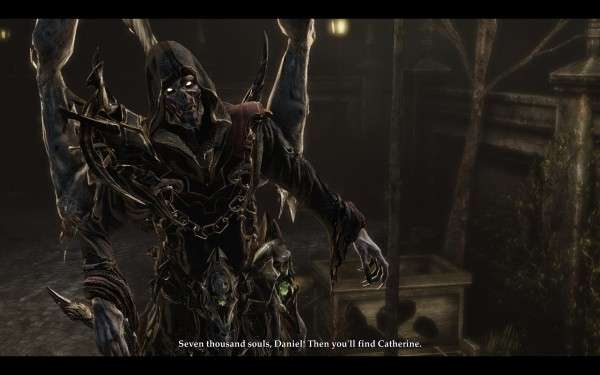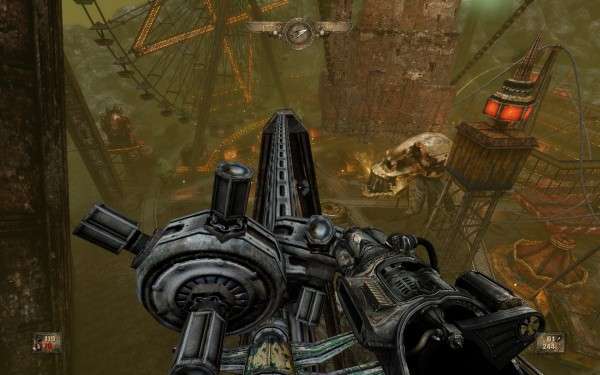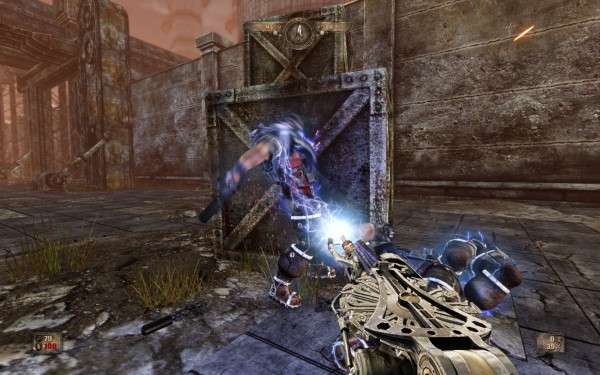
Painkiller: Hell & Damnation PC Review
I always find myself getting a little giddy when a new first-person shooter (FPS) comes along that tries to re-sprout interest in the arcade, twitch-action genre. In the 90s and early 2000s, we had a collection of great first-person shooters that emphasised pure action. Doom, Quake, Duke Nukem and Serious Sam all required the player to have fast hand-eye coordination, sharp aiming, abuse bunny hopping, and strafe around enemies just to survive. It has come to the point in this day and age where the market features so many similar FPS titles that follow the military standard gameplay, cover mechanics and extremely linear and scripted set pieces, that when something like Painkiller: Hell & Damnation comes along, it almost feels like someone just released a breath of fresh air into a very crowded room.
The original Painkiller, developed by People Can Fly, came out in 2004. For the time, the title looked fantastic on the PC. For me, the game was not just about its looks, but the speed and thrilling action that kept me alert. It was nonstop carnage; waves upon waves of enemies and gib-filled explosions that never fell short of entertaining. Plenty of sequels followed, all created by other developers, and while I never played any of these, the general statement was that these were buggy follow-ups with bad design that did nothing more than frustrate the player. What caught my eye with Painkiller: Hell & Damnation was the fact that Nordic Games are advertising it as a reboot/remake of the original and is developed by The Farm 51, a game studio that contains three industry veterans who worked on Painkiller. That can only mean good things for this reboot, right?

Painkiller: Hell & Damnation’s story is not fully based on the original Painkiller; this reboot changes some aspects of the plot, but the general theme is the same. Daniel Garner is trapped in purgatory after losing his life in a car crash. To escape, Daniel must help Death collect 7,000 souls; doing so will grant Daniel a reunion with his wife – the only thing that Daniel wants to be satisfied again. Once the introduction is over, there is not much of a story that follows. Cutscenes are kept to a minimum, mainly playing after beating a boss (voice acting is limited to those scenes), but that does not matter because Painkiller: Hell & Damnation is not about story, but about shooting thousands of enemies, nonstop, until the level is completed.
This is a game that cares nothing for progression, sneaky tactics and enemy placement. As soon as you step into that first level, the player is blasted with shredding guitar music, and surrounded by skeletons, all out to kill Daniel. This does not stop throughout the game’s 14 levels. Designers need a special set of skills to create a pure, action FPS without making the player feel bored from repetitiveness. Remember, all you do is run through environments and shoot, so why is Painkiller: Hell & Damnation fun to play? One of the reasons is the enemy design, which is made up of mostly close-range demons with a sole purpose to run at you as fast as possible. Skeletons drop down in one shot, but some of the bigger monsters, such as the fat guys with meat cleavers, take bullets as if they are plastic pellets. Before you know it, you have mastered the art of bunny hopping to get out of harm’s way, while at the same time strafing and shooting back at whatever demonic creature is tailing you.

Imaginative weapon design also helps keep the action entertaining. There are no M16s, SCAR-Ls or P90s here. Instead, this remake brings back Painkiller’s bizarre contraptions, like the stakegun (shoots out stakes), the ice shotgun, a sniper that launches five bolts or ten exploding bombs, and a new weapon – the soul catcher – that spews out spinning blades and can suck the souls out of enemies. Every weapon has a secondary fire mode, making them over-the-top and very destructive. The shotgun secondary fire causes the enemy to freeze, allowing a follow-up blast that will shatter them into pieces, while the rocket launcher has a built-in mini-gun, causing for a display of gibs and blood as the bullets shred through hell’s demons. Mix this up with plenty of ammo to collect, and you can understand the sheer fun that is to be had from shooting rocket after rocket into a group of hell-rotting beasts. Nothing comes in the way of the player and shooting a gun. Switching weapons is instant, and reloading is often nippy, so your finger is hardly ever stopped from assaulting the left mouse button.
It is a little disappointing that not all the levels return from the original and its expansion Painkiller: Battle out of Hell. The 14 levels included (plus one bonus Halloween level) are a selection from the titles mentioned, and while mostly intact with little changes here and there, they can feel disjointed when moving from stage to stage. The game can be completed in four to five hours, but those hours are always full of action and mostly contain good level design, making the time fly and the game feeling on the short side. One of my favourites is the roller coaster ride in Loony Park, where you are taken on a long ride with twists and turns, while blasting enemies from afar. Another is the opera house, in which you are put up against head-banging witches and skeleton warriors. These moments add comical laughter to the already amusing gameplay. Who has ever see a granny attack with a garbage wheelie bin?

Fans will be happy to see that the tarot card feature is still here. Tarot cards can be equipped at the start of a level and will buff Daniel in some way. The game begins with haste unlocked (half enemy movement speed), but if you manage to meet the requirements in a level (some are annoying to beat) then you will unlock more tarot cards that can increase health, deal double damage, stay active longer, or revive you. Unless modified with a tarot card, these effects can only be used once per level and are handy for the end-of-chapter bosses, which are beyond ridiculous in size.
Daniel can collect money from the ground, which is used to equip more tarot cards, as each one has an equipment cost. Souls can also be picked up from dead enemies. Collecting 66 souls activates demon mode, where the player becomes invincible and all the enemies are visibly highlighted in red and can be instantly killed with a demon blast. This is overpowered fun that you will get to use once or twice a level. I did have a slight problem with the souls – they do not spawn straight away when an enemy is killed, rather they appear 3-4 seconds later. I did not want to wait around to stop the momentum and flow of the game, so I would ignore them and carry on moving.

Cooperative play can be done for the entire single player campaign, but it feels slightly tacked on. I assume it is to keep with the old-school mentality of the genre, but having no indication where your friend is can be annoying, so you will have to use voice chat or some other communication software to coordinate the hell massacre.
Multiplayer contains deathmatch, team deathmatch, capture the flag, and survival (four players vs. waves of enemies). I wish I could report on how well the multiplayer is, but sadly I could not find one single soul to play with online, which does not bode well for anyone who liked the original’s multiplayer and was hoping to see that in a new coat of paint with a host of new players.

Unreal Engine 3 comes across as a good fit for the eerie designs of hell. While the graphics are not the best showcase of Epic’s engine, they do a good job of making the game look pleasant enough, in a dark and gritty sense, as you traverse through old castles, fairgrounds, cities and even an opera house. If you can run other Unreal Engine 3 games on your PC, then you should have no problem with playing Painkiller: Hell & Damnation.
It is a bit of a shame that it has taken a remake to get the Painkiller series back on track, but the experience from the old People Can Fly veterans and a revisit to the series’ beginnings has shown them what made it so fun in the first place. Maybe the sequels that follow will stay true to Painkiller and improve on the original’s hectic gameplay and artistic design. In the end, this FPS is made for people who want to play something of old; for gamers fed up with military games and want something different. Bringing something from the past to the present can feel refreshing when its entire heritage is lost in the current version of the genre. This is what Painkiller: Hell & Damnation is – a fun blast to the past.
